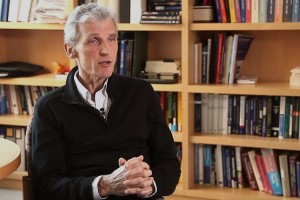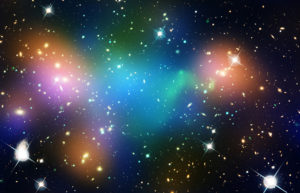The Search for Gravitational Waves
Physicist Nergis Mavalvala on the general theory of relativity, Hulse-Taylor system, and the way gravitational...
One of the biggest mysteries in the universe is dark matter. Astrophysicists have been observing the universe for many decades now and they tell us that in addition to all the visible matter we can see around us there must be some other type of matter out there. So far we’ve only see it through gravitational forces; maybe it has other forces, maybe we could detect it, we don’t know. One of the biggest puzzles in understanding of astrophysics and cosmology is what is this dark matter.
The story of dark matter started back in the 1930s when the Swiss astrophysicist Fritz Zwicky was observing galaxies in a cluster of galaxies called Coma. He found something very strange. What he discovered was that these galaxies we’re moving too fast. What do I mean by that? What I mean is that you can calculate from the galaxies that you can see how much gravitational field they generate and then you can calculate what speed galaxies would have to have in order to stay inside this gravitational field. The same way, for example, you can calculate the speed of the Earth from knowing that the gravitational field in Solar system is generated by the Sun in the middle.
So what he found was that those galaxies in the Coma cluster were moving much too fast. If there was only gravitational field that was generated by the visible matter then they should be flying away from each other, not staying inside the cluster. So he said: there must be some additional invisible form of dark matter there.
It was the 1930s. For many years people didn’t pay a lot of attention; probably the person who really convinced astrophysicists and other scientists that this dark matter has to be real was the astronomer Vera Rubin. She did something a little bit different. What she did was look at the motions of stars in a galaxy and she felt much the same effect like Fritz Zwicky: she found out that the stars in the galaxies were moving too fast. The gravitational field generated by the stars themselves was not sufficient to keep the stars in orbit around the center of the galaxy.
That was the 1970s. Since then there’d be many more pieces of evidence confirming the reality of dark matter. For example, we can measure the properties of the background radiation that fills the universe that was produced when atoms were born 380,000 years after the Big Bang. Using that light from just after the Big Bang we can figure out what there was in the universe when it was at that young age. We can tell that obviously there was radiation, obviously there was an ordinary visible matter that we’re made of, but in addition there had to be this dark matter. Using these observations we can in some sense weigh the amount of dark matter and we can compare it with the amount of visible matter. Dark matter is somewhere between five and ten times as much as visible matter in the Universe. That’s why I say that the existence of dark matter is well-established and it’s the biggest puzzles we have in our understanding of the universe.
Next question is, what is this dark matter made of? One possibility is that it is made of some sort of miniscule particle, like the ones that we see in our particle accelerators, although it would have to have different properties and the particles that we know about could not explain the dark matter. For one thing, the dark matter particle would not have any electric charge or, perhaps, have a very-very small electric charge, so it’s not the same as an electron or a proton. It would have to have very weak interactions, so it couldn’t be made of neutral elementary particles like neutrons, for example. It would have to have a relatively large mass, so it couldn’t be a neutrino, for example. So it would have to be some additional type of particle, something that we’ve not met before.
There’s all sorts of different ideas about what that dark matter particle might be. Depending on those ideas people propose different ways of trying to detect it and pin down exactly what it is. When you’re doing these experiments to look for dark matter you can look for it directly. According to the theory, here we are sitting in this room and there are dark matter particles coming through it all the time. And you think: well, if there’re dark matter particles coming through all the time it must be simple to detect them? Well, not so simple, because their interactions must be very-very weak and if you try it to measure their properties here on the surface of the Earth you would have enormous backgrounds from things like the cosmic rays that come from the outer space. So what people do is to go to into deep underground laboratories where they don’t get these cosmic rays, they’re shielded by the Earth. There they look for very rare, very weak collisions between these possible dark matter particles and ordinary matter. So there’s a lot of experiments that they’re doing that at the moment but so far they haven’t found any signs of the dark matter particles.
What else could you do? Well, if they really are particles and if they weigh less than, let’s say, a thousand times as much as a proton then collisions of protons at high-energy particle accelerators might produce particles of dark matter. That’s been one of the big experimental programs at the CERN Large Hadron Collider and they’ve been looking for the production directly of these dark matter particles. You don’t actually see the dark matter particle itself, because it doesn’t have the electric charge, doesn’t interact in the detector, but after it’s being produced it carries away energy and momentum that you can detect. So what you do is you draw out a sort of balance sheet of all the energy and momentum after the collision and you look to see whether it balances or not. If it doesn’t, you say: well, maybe that’s dark matter.
Those are two of the ways that people are currently looking for dark matter particles. Another possibility that people are studying is: if you’ve got these dark matter particles around us in the universe today, every once in a while they may collide with each other. And when they collide they might produce particles that we can actually detect, for example, amongst the cosmic rays. That’s another thing that astronomers and astrophysicists are doing: they are looking for unexpected particles in the cosmic rays. But again, so far no luck.
In view of this lack of success so far, people are considering other possibilities for this dark matter. For example, a few years ago gravitational waves were discovered from the merges of black holes. So people revived an old suggestion there maybe the dark matter isn’t in the form of small particles at all but instead it’s in the form of massive black holes. Well, there’s all sorts of problems with that idea: how’d you make that many black holes? There’s all sorts of the astrophysical restraints limiting the possible density of such black holes. So I don’t think that idea works, but still: maybe some fraction of the dark matter might be made up out of black holes.
Another possibility is that the dark matter doesn’t consist of individual objects, individual particles, but instead is in the form of some sort of wave through the universe and depending on how deep or how dense this wave is then you make it some dark matter. There are people who are looking for that possibility.
Anyway, that’s where we are at the moment. Dark matter is a big puzzle, it’s a puzzle that’s been with us for more than 80 years. Astrophysicists, cosmologists, particle physicists have been studying it in great detail for at least 40 years. We’ve come up with lots of ideas for what that dark matter might be, the ideas range from very heavy black holes all the way down to waves of invisible particles. There’s all sorts of experimental efforts to look to see what that dark matter might be. At the moment we have no direct evidence but for me it’s one of the most exciting outstanding questions, I’d say, not just in astrophysics and cosmology, but also a particle physics because it suggests that there’s a whole world of particles out there which we don’t know anything about yet.

Physicist Nergis Mavalvala on the general theory of relativity, Hulse-Taylor system, and the way gravitational...

Nobel Prize-winning physicist Wolfgang Ketterle on simulating superfluidity, 'atomic Legos', and a special-pur...

Astrophysicist Simon White on dark matter, its role in explaining the formation of the universe, and the chall...